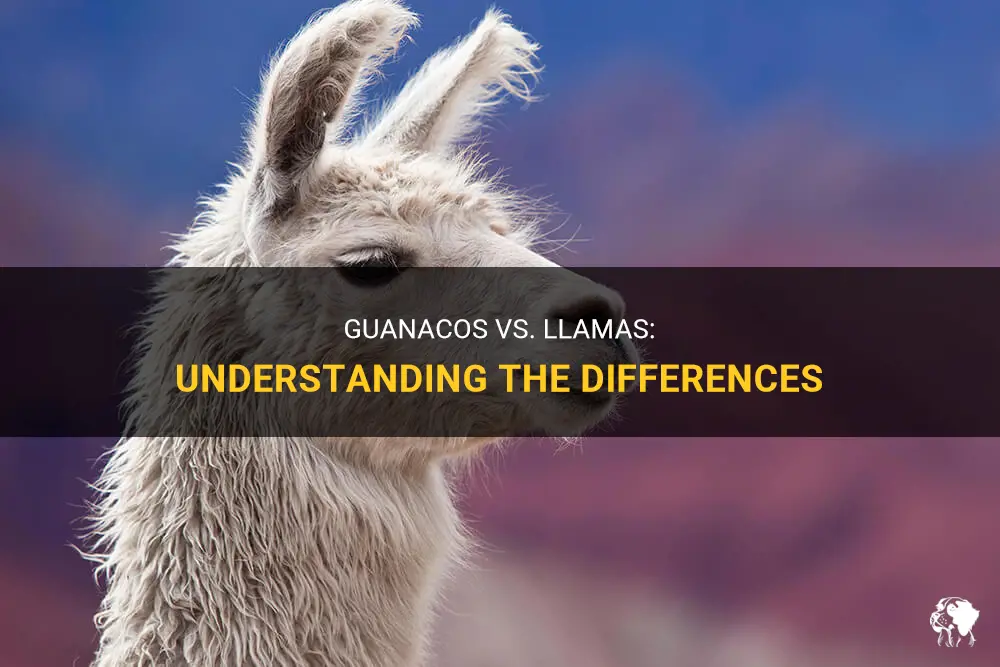
Guanacos and llamas are fascinating animals that have long captured the imagination of people worldwide. These camelids are native to the mountains of South America and are known for their distinctive appearance, elegant gait, and adaptable nature. Both guanacos and llamas have played crucial roles in the cultures and economies of Andean civilizations for centuries, serving as essential pack animals, sources of food and fiber, and even symbols of wealth and prestige. In this article, we will explore the intriguing characteristics and histories of these remarkable creatures and delve into the many ways they have left their mark on both the natural and human landscapes of the Andean region.
| Characteristics | Values |
|---|---|
| Scientific name | Lama guanicoe |
| Family | Camelidae |
| Average height | 1.15 to 1.45 meters |
| Average weight | 90 to 140 kg |
| Habitat | Andean grasslands |
| Range | South America (Argentina, Chile, Peru, Bolivia) |
| Diet | Herbivorous (grasses, leaves, shrubs) |
| Social behavior | Herd animals |
| Gestation period | 11 to 12 months |
| Lifespan | 20 to 25 years |
| Predators | Puma, foxes, and humans |
| Conservation status | Least Concern |
What You'll Learn

Are guanacos and llamas the same animal?
Guanacos and llamas are not the same animal; they are two distinct species from the same family, Camelidae. While they are similar in appearance and share a common ancestor, there are several differences that set them apart.
Firstly, guanacos and llamas have different physical characteristics. Guanacos are wild animals native to the mountainous regions of South America, particularly the Andes. They have a slender body structure, with long legs and a small head. On the other hand, llamas are domesticated animals that have been selectively bred over thousands of years. They are larger and heavier than guanacos, with a more robust build.
Another difference lies in their behavior. Guanacos are typically more skittish and wary of humans, as they have not been domesticated. They are known for their agility and speed, often running away when approached. Llamas, on the other hand, have been bred for their docile temperament and are commonly used as pack animals. They are more comfortable around humans and can be trained and handled more easily.
Furthermore, guanacos and llamas have different uses to humans. Guanacos are primarily valued for their fine wool, which is softer and more luxurious than llama wool. Their wool is highly prized for its quality and is often used to make high-end clothing and textiles. Llamas, on the other hand, are used for a variety of purposes. They are commonly used as pack animals, carrying heavy loads across difficult terrain. Their wool is also used for making clothing and textiles, but it is generally coarser and less expensive than guanaco wool.
In terms of habitat, guanacos and llamas have adapted to different environments. Guanacos are well-suited to survive in harsh and extreme conditions, such as the high altitudes and cold temperatures of the Andes mountains. They are highly mobile and can cover long distances in search of food and water. Llamas, on the other hand, have been bred for their ability to thrive in more diverse environments. They can tolerate a wider range of temperatures and are found in various habitats, from high mountains to lowlands.
To summarize, guanacos and llamas are two closely related but distinct species. While they share a common ancestor and have similar appearances, they have different physical characteristics, behaviors, uses, and habitats. Understanding these differences is essential for appreciating the unique qualities of both species and the importance they hold in their respective ecosystems.
The Magic of Llama AI: Unleashing the Power of Natural Language Processing
You may want to see also

What are some physical differences between guanacos and llamas?
Guanacos and llamas are two species of mammals that belong to the camelid family. While they share some similarities, there are also distinct physical differences between the two.
One of the main differences is their size. Guanacos are generally larger than llamas, with adult males reaching a height of up to 6 feet at the shoulder and weighing around 300 pounds, while adult llamas typically stand at around 4 feet tall and weigh between 250 and 300 pounds. This size difference is the result of both genetic and environmental factors. Guanacos are found in the wild, where they need to be larger and stronger to navigate challenging terrain and fend off predators, while llamas have been selectively bred for thousands of years by humans for their smaller size and docile nature.
Another noticeable physical difference between guanacos and llamas is their coat. Guanacos have a more wild and rugged appearance, with long, coarse hair that is usually a light brown or reddish color. Their coat is thicker and denser, providing them with better insulation against the cold temperatures they encounter in their natural habitat. In contrast, llamas have been selectively bred for their wool, and their coat is softer, denser, and more luxurious. Llamas come in a variety of colors, including white, black, brown, and grey, and their wool can be used for various purposes, such as clothing and textiles.
The ears of guanacos and llamas also differ in size and shape. Guanacos have longer, more pointed ears compared to llamas, which have shorter and more rounded ears. This difference in ear shape is thought to be an adaptation to their respective environments. The pointed ears of guanacos help them detect sounds from far distances, allowing them to stay alert to potential threats in their natural habitat, while the rounded ears of llamas are a result of domestication and selective breeding.
Additionally, guanacos and llamas have different body proportions. Guanacos have more elongated necks and legs, which give them a sleek and agile appearance. This physical adaptation allows them to run fast and maneuver through rocky terrains with ease. On the other hand, llamas have shorter necks and legs, giving them a more stocky and sturdy build. This makes llamas well-suited for carrying heavy loads and serving as pack animals.
In conclusion, guanacos and llamas have several physical differences that distinguish them from each other. These differences include their size, coat, ear shape, and body proportions. Understanding these physical characteristics is important for both scientists studying these animals and individuals who interact with them in various settings, such as farmers or owners of these animals.
Are Alpacas Friendlier than Llamas? A Comparative Study
You may want to see also

How are guanacos and llamas used by humans?
Guanacos and llamas are two species of camelids that belong to the same family as camels. These animals have been domesticated for thousands of years and have played a crucial role in the lives of humans in the Andean region of South America. In this article, we will explore how guanacos and llamas are used by humans for various purposes.
Firstly, guanacos and llamas are primarily used for their fiber. The wool of these animals is highly prized for its warmth and softness. It is used to make various products, including clothing, blankets, and rugs. The wool is known for its natural insulation properties, making it ideal for cold climates. Additionally, the wool can be dyed in different colors, allowing for a wide range of creative possibilities.
In addition to fiber, guanacos and llamas are also used as pack animals. Their ability to carry heavy loads for long distances makes them ideal for transporting goods in the mountainous terrain of the Andes. These animals can easily navigate through narrow paths and steep slopes, making them highly valuable for local communities. They are used to transport crops, building materials, and other essential items.
Furthermore, llamas have been traditionally used for their meat and milk. Llama meat is lean and high in protein, making it a nutritious choice for human consumption. Llama milk, although less commonly consumed, is used to make cheese and other dairy products. Both the meat and milk provide an important source of sustenance for communities living in remote areas.
Moreover, guanacos and llamas are also used in traditional ceremonies and festivals. These animals hold significant cultural and spiritual value for indigenous communities in the Andes. They are often adorned with colorful decorations and participate in processions and rituals. These ceremonies are an important part of the local culture and are preserved through generations.
Lastly, the dung of guanacos and llamas is utilized as an essential source of fuel and fertilizer. In many rural areas of the Andes, where firewood is scarce, dried dung is used as a cooking fuel. Its high calorific value and easy availability make it an efficient alternative. Additionally, the dung is collected and used as a natural fertilizer for crops, contributing to sustainable agricultural practices.
In conclusion, guanacos and llamas have a wide range of uses for humans in the Andean region of South America. From providing fiber for clothing to serving as pack animals, these animals play a crucial role in the lives and livelihoods of local communities. Their meat, milk, and participation in cultural ceremonies further highlight their importance. Furthermore, their dung serves as a valuable source of fuel and fertilizer. Overall, guanacos and llamas are not just animals but invaluable companions to humans in the Andean region.
Unlock the Magic: How to Harness the Power of Llama AI
You may want to see also

Are guanacos and llamas found in the same regions?
Guanacos and llamas are both members of the Camelidae family and are closely related to each other. They are found in various regions, but there are some differences in their distribution and habitats.
Guanacos (Lama guanicoe) are native to South America and are primarily found in the high-altitude regions of the Andes Mountains. They are native to countries such as Argentina, Chile, Peru, Bolivia, and parts of Ecuador. Guanacos are well-adapted to harsh mountainous environments and can survive in extreme temperatures and altitudes. They are often found in grasslands, shrublands, and deserts.
On the other hand, llamas (Lama glama) are domesticated descendants of guanacos. They were originally domesticated by the indigenous people of the Andes for their wool, meat, and as pack animals. Llamas are now found in various regions around the world, including the Andean regions of South America, North America, Europe, and Australia. They are well-suited for high-altitude regions and can be found in similar habitats as guanacos, such as grasslands and shrublands.
While guanacos are primarily wild animals, llamas are domesticated and are often used for their wool, meat, and as pack animals. They have been selectively bred for thousands of years, leading to different variations in size, coat color, and temperament compared to their wild counterparts.
In terms of physical appearance, guanacos and llamas have some similarities but also some differences. Both species have long necks, slender bodies, and camel-like humps. However, guanacos are generally smaller and have shorter and coarser fur compared to llamas. Llamas also have a more docile and sociable nature compared to guanacos, making them easier to handle and domesticate.
In conclusion, guanacos and llamas are closely related camelid species found in various regions. Guanacos are native to South America and primarily found in the high-altitude regions of the Andes Mountains, while llamas are domesticated descendants of guanacos and are found in various regions worldwide. While there are some similarities in their habitats and physical appearance, there are also notable differences between the two species.
The Fascinating Facts: What is a Llama Animal?
You may want to see also

Can guanacos and llamas interbreed?
Guanacos and llamas are both members of the camelid family and share certain genetic similarities. As a result, it is possible for them to interbreed, although the success of such crosses can vary.
Before delving into the details of guanaco and llama interbreeding, it is important to understand the differences between the two species. Guanacos, native to South America, are wild animals that resemble a smaller version of llamas. They have a slender body, long neck, and thick fur, which helps them withstand the harsh climates of the Andes Mountains. Llamas, on the other hand, are domesticated animals that have been bred for various purposes, such as pack animals and fiber production.
The interbreeding between guanacos and llamas is referred to as a crossbreeding or hybridization. When a male guanaco mates with a female llama, the offspring is called a guama. Similarly, if a male llama mates with a female guanaco, the offspring is called a llamaco. These hybrids possess characteristics of both parent species, including the body size of a llama and the coat color and pattern of a guanaco.
In terms of the success of interbreeding, it is generally easier for llamas to reproduce with guanacos compared to the other way around. This is because llamas have been domesticated for many generations and have undergone selective breeding, which has made them more adaptable to breeding with other camelid species. Guanacos, being wild animals, are more resistant to hybridization, and the success rate of their crosses with llamas can be lower.
Breeding guamas and llamacos can be a challenging process, as it requires careful management and knowledge of camelid genetics. It is important to select suitable individuals for breeding, ensuring that the guanaco or llama used is healthy and of breeding age. Additionally, timing and proper care during the mating process are crucial for a successful crossbreeding.
While the primary motivation for interbreeding guanacos and llamas is usually to produce unique and desirable traits, such as a specific coat color or pattern, it is important to consider the welfare of the offspring. Hybridization can sometimes result in health issues or reproductive problems for the offspring, and the long-term consequences of these crosses are still not fully understood.
In conclusion, guanacos and llamas can interbreed, resulting in hybrid offspring known as guamas or llamacos. However, the success of such crosses can vary, with llamas being more adaptable to hybridization compared to guanacos. Careful management and consideration of the welfare of the offspring are crucial when attempting to interbreed these two species.
Understanding the Diet of Llamas: What Do They Eat?
You may want to see also
Frequently asked questions
No, guanacos are not llamas. While both species belong to the Camelidae family and are native to South America, they are distinct and separate species. Guanacos are wild animals that are found in the highlands of the Andes, while llamas are domesticated animals that have been bred for centuries by indigenous cultures for their wool and meat.
Guanacos and llamas differ in several ways. Guanacos are smaller in size, with a slender body and long legs, while llamas are larger and have a sturdier build. Guanacos have a sleeker coat of fur, whereas llamas have a thicker and more woolly coat. Additionally, guanacos are wild and not domesticated, while llamas have been domesticated for thousands of years.
Guanacos are inherently wild animals and have not been successfully domesticated like llamas. While guanacos can be somewhat tamed and trained, their natural instincts and behaviors make them less suitable for domestication compared to llamas. Llamas, on the other hand, have been selectively bred for their docile and gentle nature, making them highly adaptable to living with humans.
Guanacos are currently classified as a species of "Least Concern" on the IUCN Red List. While their population numbers have declined in some areas due to hunting, habitat loss, and competition with livestock, they are still relatively abundant overall. Conservation efforts, such as protected areas and sustainable management plans, are in place to ensure the long-term survival of guanacos and their habitats.
Llamas are not considered a threatened species and are not listed on the IUCN Red List. As domesticated animals, llamas are bred and raised in captivity by humans. However, certain populations of wild vicuñas, which are closely related to llamas, are considered endangered or threatened due to habitat loss and illegal hunting for their valuable wool. Efforts are being made to protect and conserve these wild vicuña populations.







